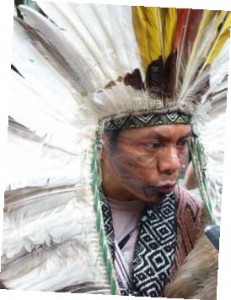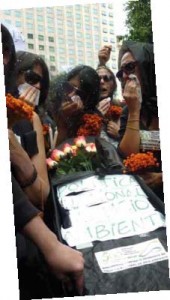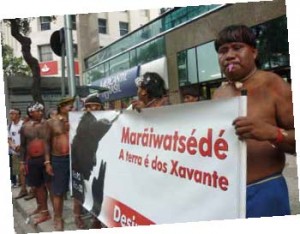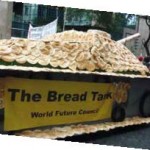By Fabiana Frayssinet
A War Cry Against the Merchants of Nature
 The grey city streets and a few sparse trees contrast dramatically with the colourful traditional clothing, feathered headdresses and face and body paint of a group of indigenous people from the northern Brazilian state of Acre. But if the destruction of their home, the Amazon rainforest, is not halted, it will not be long before this desolate urban landscape takes over their own lands.
The grey city streets and a few sparse trees contrast dramatically with the colourful traditional clothing, feathered headdresses and face and body paint of a group of indigenous people from the northern Brazilian state of Acre. But if the destruction of their home, the Amazon rainforest, is not halted, it will not be long before this desolate urban landscape takes over their own lands.
“The Brazilian government wants to sell our nature and our lands, our forest. It is causing the disappearance of the rivers, the animals, and the people of the rainforest,” indigenous leader Jaminawá Junikuin told TerraViva.
The Widows of Rio
  Amid the vibrant colours of a multiethnic demonstration, one group of women stands out with their black dresses and dark glasses. They weep inconsolably over a closed coffin. Who died? “Environmental policy,” they answer in unison.
 Amid the vibrant colours of a multiethnic demonstration, one group of women stands out with their black dresses and dark glasses. They weep inconsolably over a closed coffin. Who died? “Environmental policy,” they answer in unison.
The women are Brazilian government employees who decided to use black humour to condemn what they consider to be not merely a death, but a violent murder. “The killer waseconomic power, that formula for development that Brazil and other countries apply at the cost of the environment, and which has destroyed environmental policies, traditional communities, forests and artisanal fishing,” they declared.
The Race of the Xavante People
 A group of 20 Xavante indigenous men, running in the opposite direction from the marchers and carrying logs, frightened a few unsuspecting city dwellers. But much greater is the fear of these natives of the western state of Mato Grosso as they watch their forests disappearing at a faster pace than their traditional “log races”.
A group of 20 Xavante indigenous men, running in the opposite direction from the marchers and carrying logs, frightened a few unsuspecting city dwellers. But much greater is the fear of these natives of the western state of Mato Grosso as they watch their forests disappearing at a faster pace than their traditional “log races”.
An elder from the village of Marãiwatsédé, Luis Tserewamriwe Tserenhitomo, told TerraViva that large landowners are “stealing our lands.”
Francisco Tserewamriwe Tserenhitomo, a younger Xavante, explained that the landowners have brought diseases to their communities, and are planting soybeans where they used to plant corn and other subsistence crops.
A Tank That Wages War on Hunger
 A tank covered in bread advances menacingly among the protestors. But its gun is aimed at a noble target: ending world hunger.
A tank covered in bread advances menacingly among the protestors. But its gun is aimed at a noble target: ending world hunger.
The “bread tank” is an edible, mobile sculpture created by the nongovernmental World Future Council to
back its Disarmament for Sustainable Development campaign. It was presented to the press in the Rio de Janeiro favela of Santa Marta on Jun. 19, and thenaccompanied the Global Day of Action
March in Rio to highlight the need to invest in food instead of weapons.







 Add to Google
Add to Google







